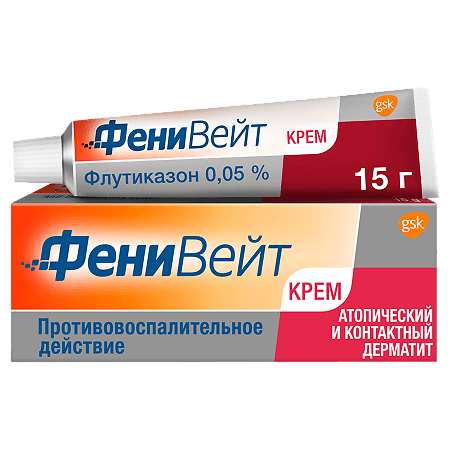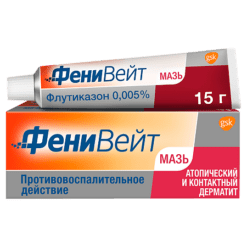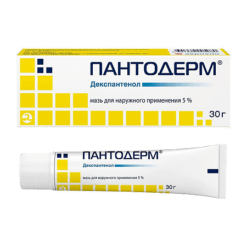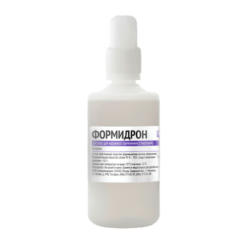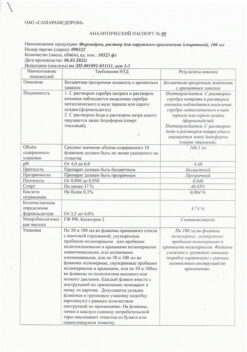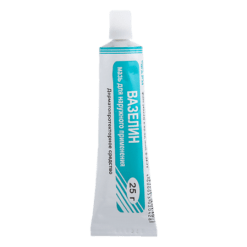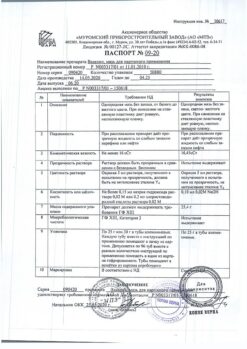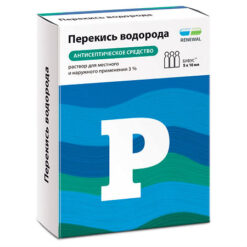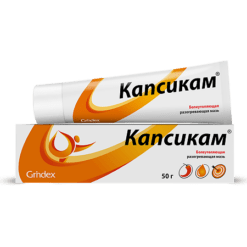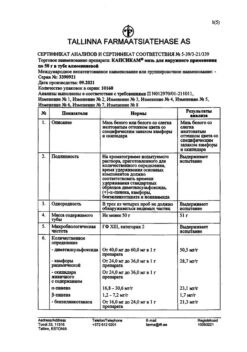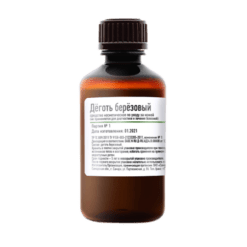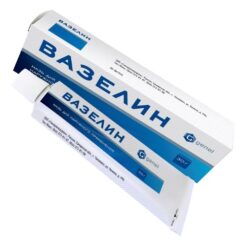No products in the cart.
FeniVeit, cream 0.05% 15 g
€17.78 €14.82
Description
Due to limited absorption of fluticasone through the skin, the bioavailability of the drug when used externally is very low. The bioavailability of fluticasone when ingested is close to zero due to very low gastrointestinal absorption and extensive metabolism during “first passage” through the liver, which ensures low systemic exposure if the drug is accidentally swallowed.
Distribution
After entering the systemic bloodstream, fluticasone rapidly enters the bile and is excreted through the intestine. The degree of binding to plasma proteins is quite high (91%). Fluticasone does not accumulate in tissues and does not bind to melanin.
Metabolism
According to the results of preclinical and clinical studies, fluticasone has a high metabolic clearance with subsequent rapid excretion from the body. Thus, the drug, having entered through the skin into the systemic bloodstream, is quickly inactivated. The main route of metabolism is hydrolysis to carboxylic acid; this metabolite has very weak glucocorticosteroid and anti-inflammatory activity.
Elimation
The excretion rate of intravenously administered fluticasone propionate is linear over a dose range of 250 to 1000 µg and is characterized by a high blood plasma clearance (CL=1.1 L/min).
The maximum plasma concentrations are reduced by approximately 98% within 3-4 hours, and only low plasma concentrations have been associated with a final half-life of 7.8 hours. Renal clearance of fluticasone propionate is insignificant (
Pharmacodynamics
Mechanism of action
Glucocorticosteroids for external use have anti-inflammatory properties. The anti-inflammatory properties are due to multiple mechanisms of inhibition of the late phase of allergic reactions, including reduction of mast cell number, attenuation of eosinophil chemotaxis and activation, reduction of cytokine production by lymphocytes, monocytes, mast cells and eosinophils, and inhibition of arachidonic acid metabolism.
Fluticasone is a glucocorticosteroid (GCS) with a strong local anti-inflammatory effect. Fluticasone propionate is highly lipophilic, which allows it to penetrate the double lipid layer of the target cell and bind to glucocorticoid receptors in the cytoplasm.
In vitro studies have shown that fluticasone has high selectivity and affinity for glucocorticosteroid receptors.
The fluticasone propionate-receptor complex stimulates or inhibits iRNA transcription and subsequent protein synthesis. The production of enzymes responsible for the anti-inflammatory effect is increased while the production of inflammatory mediators is reduced.
The production of enzymes responsible for the anti-inflammatory action is increased while the production of inflammatory mediators is decreased. When applied to the skin, there is little possibility of suppression of hypothalamic-pituitary-adrenal system (GnA) function.
According to clinical studies, if fluticasone enters systemic blood flow, it is quickly transformed in the liver to inactive metabolite (17β-carboxylic acid) with subsequent rapid excretion from the body. Due to these properties FeniVeit has a high therapeutic index.
Pharmacodynamic effects
Fluticasone does not cause unforeseen hormonal disturbances and has no significant effect on the central and peripheral nervous system, gastrointestinal tract, cardiovascular and respiratory systems.
Indications
Indications
Active ingredient
Active ingredient
Composition
Composition
How to take, the dosage
How to take, the dosage
Interaction
Interaction
Contraindications
Contraindications
Do not use on closed skin areas (such as diaper rash or under occlusive dressings).
With caution:
Renal insufficiency, hepatic insufficiency, old age, childhood (10 to 12 years old).
Side effects
Side effects
The undesired reactions presented below are listed according to organ and organ system involvement and frequency of occurrence. The frequency of occurrence is defined as follows: Very common (⥠1/10), common (⥠1/100 and
Infectious and parasitic diseases: Very rare – Opportunistic infections.
Immune system disorders: Very rare – Hypersensitivity*: itching at the application site, rash, swelling.
Endocrine system disorders (GGNS inhibition): Very rare – Weight gain or obesity; Slow weight gain or stunting in children; Cushingoid features (e.g., moon-shaped face, central obesity); Decreased endogenous cortisol concentration; Hyperglycemia or glucosuria; Arterial hypertension; Osteoporosis; Cataracts; Glaucoma.
Skin and subcutaneous tissue disorders
Often – Itching at the site of application of the ointment.
Infrequent – Burning at the place of application.
very rarely – Thinning of the skin, atrophy, stretch marks, telangiectasia, changes in pigmentation, hypertrichosis, allergic contact dermatitis, exacerbation of symptoms of the underlying disease, pustular psoriasis, erythema, rash, urticaria.
* Local hypersensitivity reactions may resemble the symptoms of the disease for which this therapy is used.
The occurrence of any of the adverse reactions noted above should be reported to the physician. The decision about further treatment strategy should be made by the physician.
If any of the adverse reactions listed in the instructions worsen, or if you notice any other adverse reactions not listed in the instructions, tell your doctor.
Overdose
Overdose
Symptoms
Fluticasone may be absorbed in sufficient quantities to cause systemic action when used topically. The likelihood of acute overdose is extremely low, but signs of hypercorticism (Icenko-Cushing’s syndrome) may develop with chronic overdose or improper use of FeniVate.
Treatment
In fluticasone overdose, the drug is withdrawn gradually by reducing the frequency of application or switching to a less active GCS to avoid the risk of glucocorticoid failure. If the clinical picture of drug overdose develops, symptomatic therapy is indicated.
Pregnancy use
Pregnancy use
Fertility
There are no available data to evaluate the effect of topical GCS on human fertility. No effect of fluticasone propionate on fertility has been found in animal studies.
Pregnancy
Limited data are available on the use of fluticasone during pregnancy. In studies of reproductive function in animals, adverse effects typical of strong corticosteroids were observed only at high levels of systemic exposure.
Preclinical studies have found that external use of corticosteroids in pregnant animals can cause abnormal embryonic development, but the significance in humans has not been established.
The use of the drug in pregnancy is not recommended unless the benefit to the mother exceeds the potential risk to the fetus and only under medical supervision. Before using during pregnancy it is necessary to consult a doctor. The ointment should be applied in the minimum amount for the shortest period of time sufficient for the clinical effect to be evident.
Breastfeeding
The safety of topical GKS therapy during breastfeeding has not been established.
There are no data available to support the possibility of systemic absorption of external GCSs to an extent sufficient to be detected in breast milk.
Preclinical studies have shown that fluticasone was detected in milk during breastfeeding when administered subcutaneously in amounts sufficient to be detected in plasma.
The use of the drug during breastfeeding is not recommended unless the expected benefit to the mother outweighs any possible risks to the baby. Consult a physician before using during breastfeeding.
When using during breastfeeding, the drug should not be applied to the mammary gland area to prevent accidental ingestion by the baby.
Similarities
Similarities
Additional information
| Weight | 0.141 kg |
|---|---|
| Manufacturer | GlaxoSmithKline Pharmaceuticals S.A., Poland |
| Medication form | exterior cream |
| Brand | GlaxoSmithKline Pharmaceuticals S.A. |
Other forms…
Related products
Buy FeniVeit, cream 0.05% 15 g with delivery to USA, UK, Europe and over 120 other countries.

